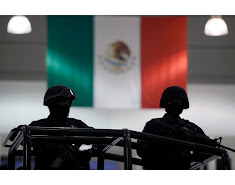The scars on Jose Aguilar’s hands are pretty standard stuff for a man who’s made a rough living carving up cattle. He dismisses them as “nada” — nothing. It’s the mark on his scalp, where he was clubbed with a tire iron, that leaves a lasting mark on his psyche. Aguilar is like so many immigrant workers in town who provide easy prey for American born-and-bred Latino gang bangers. He’s in the country illegally. He speaks virtually no English. He is, he says, essentially illiterate even in Spanish. Many of his fellow Guatemalan expatriate slaughterhouse workers don’t use banks, consequently carrying and stashing cash — drawing robbers like ants to a picnic. They’re also smaller than just about everybody else in Dodge City. And they tend not to call the cops. So the thugs who busted into his home a few years ago could reasonably think they could bully him as they pleased. “They can do what they want to us,” said Aguilar, who’s scheduled for deportation this summer. That may be changing. The message from the Dodge City police chief that even immigrants in the country illegally should call for help — “we want to protect them from crime, and that’s it” — seems to be getting through. And earlier this month 23 members of the Nortenos gang in Dodge City were swept up in a federal racketeering indictment with allegations ranging from robbery to murder. The resulting arrests have carved the heart out of what has been a harrying presence in the poorest neighborhoods on the east and south sides of town. For years the gang had posed a menace in Dodge City: red-clad young men dealing methamphetamine and robbing the transient immigrants who flock to jobs in western Kansas slaughterhouses. It’s tempting to look at what’s been happening in Dodge City in recent years as Latino-on-Latino crime. Indeed, some of what was spelled out in the racketeering indictment stems from gang tit-for-tat, beatings that begat payback stabbings that spawned drive-by shootings between rival outfits. Yet what sustained the only occasionally employed gang members, police and prosecutors say, was ruthless extortion of immigrants, people who came to western Kansas — some legally, some not — to eke out a modest living in the stench and tedium of beef packing plants. One 30-year-old man supports his small family — and sends hundreds of dollars each month back to relatives in Guatemala — carving the bones out of chuck roast at the National Beef Packing Co. plant in Dodge City. He remains, he says, constantly aware of young men with the cholo look of tough guys. “I don’t go out at night. I don’t walk places,” said the man, who spoke through a translator and asked not to be named because he’s in the country illegally. “I avoid people I don’t know.” Too many of his friends have been robbed coming from check-cashing shops or had their doors kicked in by robbers in gang colors. Gang presence Police say gangs first gained a toehold in Dodge City in the early 1990s. Then, as now, the members were teenagers and young men who adopted the name and aesthetic of the Nortenos —a gang born in California prisons. Nortenos, Spanish for northerners, named themselves such because they came mostly from northern reaches of the state. Surenos, or southerners, are their chief Latino rivals. Police say the connection between the large California gangs and those in Dodge City is the loosest of affiliations. The Dodge City guys, they say, mostly copied what they could learn about the Californians. The Dodge City Police Department sees the local gang bangers as a bunch of knuckleheads, albeit dangerous knuckleheads willing to threaten cops and not much concerned about the peril they pose to people sometimes caught in the Nortenos-Surenos crossfire. Cops describe the membership as guys who rarely take legitimate jobs, who both sell and use meth. Despite their robberies and burglaries, they seem always to be in need of more cash. And nearly always, particularly on the Thursdays when packing house workers get paid, that needed cash is never too far away. “The Guatemalans who come here are hard-working people,” said Sister Angela Erevia, the director of Hispanic ministry for the Catholic Diocese of Dodge City. “They’re also very docile.” So it became all too commonplace for young workers leaving a convenience store to be beaten by far bigger, often armed, gang members for the money they’d just pocketed after cashing their paychecks. Just as common were night-time break-ins, where typically four to six men, often masking their faces with bandanas, would kick in the doors of the rental homes of Guatemalans. “Happened all the time,” said Dodge City Police Lt. Colleen Brooks. “These guys would pistol whip anybody.” Afterward, threatened with murder and fearful that contact with any authorities might invite deportation, immigrants have often kept such attacks to themselves, Brooks said. Donald Stull has been studying the crossroads of immigration and meat packing for years. The University of Kansas anthropologist describes desperate workers taking jobs that few American-born folks are willing to tackle. The packing houses are basically disassembly plants that reduce giant herds of cattle into sirloins and hamburger at an incredible clip. (The Cargill plant in Dodge City, for instance, employs about 2,700 people slaughtering 6,000 animals a day.) The immigrant workers may be reluctant to use banks because they never have, he said. And they can be reluctant to seek help from police for cultural reasons even if they’re in the country legally. “White Americans tend to think the policeman is generally your friend,” Stull said. “It very easily might not have been that way if you grew up in Guatemala, where he wasn’t necessarily there to help you.” Dodge City Police Chief Craig Mellecker said his department went to local churches for help. (Services at the Cathedral of Our Lady of Guadalupe on Sunday afternoons are conducted in the Guatemalan dialect of Quiché for parishioners who speak neither English nor Spanish.) The department gave tips on how to identify gangs from their tattoos and the way they dress and gave advice on using banks. “Mostly, we wanted to get across the message that we didn’t care about their (immigration) status,” Mellecker said. Meantime, the Police Department started working with agents from the U.S. Bureau of Alcohol, Tobacco, Firearms and Explosives about three years ago. The ATF was interested in the illegal use and sale of guns. Gang members are accused of selling guns stolen in burglaries on a black market. That opened up an opportunity for federal involvement, resulting in federal racketeering charges. Building a case Investigators slowly began piecing together a case that would put the Nortenos in reach of the federal courts and their famously tough sentencing standards. U.S. Attorney Barry Grissom said the case posed a chance to rid Dodge City’s streets of its latter day gunslingers. It could be hard at times getting victims to cooperate because so many feared that stepping forward would either put them at risk of gang retaliation or expose anyone in a household whose immigration status was dicey. “We didn’t care about that,” Grissom said. “The bullets don’t separate who’s documented and who’s not.” It led to a case that Grissom took to a grand jury this spring and that produced an indictment returned in mid-April. The charges remained under court seal for almost four weeks until all but one of the defendants was arrested. The 38-count indictment named the reputed leader of the local Nortenos, 28-year-old Jason Najera, and a cast of characters with nicknames such as Wee Wee, Pistol Pete, Cheese, Beaver, Shrek and Bugsy. They formed two local chapters of the Nortenos, the larger Diablo Viejos (old devils) and mostly older gang members that go by LCC (an acronym for a vulgarism). Just one of the nearly two dozen men charged in the case was identified as an illegal immigrant. The grand jury contended the Nortenos aimed at “keeping victims in fear of the enterprise and in fear of its members and associates through actual violence and threats of violence.” To that end, according to the charges, gang leaders demanded potential members commit at least two acts of drug peddling, robbery or murder to earn a place in the Nortenos. Doing so, the charges allege, established their standing within what amounted to a miniature crime syndicate as defined by the Racketeer Influenced Corrupt Organization Act, or RICO. Crimes alleged in the indictment date back to 2008 and stretch to this February. They include multiple conspiracies to commit murder, including in the killing of Israel Peralta and the wounding of another man outside a Dodge City trailer park. Police believe that incident stemmed from Nortenos mistaking a beer-drinking group of men for their rivals, the Surenos. Some of the other crimes stem from what authorities view as gang-on-gang violence. Most of the victims, however, were meat cutters, targeted by the gang for their vulnerability, authorities say. The cinching of the indictment elated the Dodge City cops, who quickly mobilized teams to round up the defendants. Over the last two decades, the city has seen gang crime rise and fade, often peaking before a big bust, then peaking again when key players walk out of jail. This, though, is hoped to be different. RICO convictions could lead to prison sentences that convert young suspects into middle-aged convicts. Rounding up 23 gang members in Dodge City, said U.S. Attorney Grissom, is akin to arresting 200 in Kansas City. The city is ringed by grain elevators that supply sustenance to surrounding feedlots where the cattle are fattened before slaughter. Its main drag is Wyatt Earp Boulevard, now filled with chain restaurants and motels. Dodge City is home to about 27,000 people on the eastern edge of the Great Plains. Its industry is anchored by two large packing plants. They’ve helped keep unemployment below 5 percent. Unlike much of western Kansas, Dodge City has been growing steadily in the 21st century on the same cattle trade that founded the community in the 19th century. The difference now is that immigrant packing house workers continue to shift its demographics. In 2000, the city was about 43 percent Latino. Today that number is more than 57 percent. Now Dodge is bracing for what the racketeering case could bring. The disappearance of significant numbers of Nortenos in the past has led to a bolder Sureno gang, and vice versa. But local authorities hope the racketeering case sends an intimidating message to gang members that the possibility of stiff prison terms makes the thug life unattractive. At the same time, there’s hope that it adds to gradual gains in the willingness of immigrant packing house workers to come forward about beatings and robberies. “I don’t want this place to be like some border town where everybody’s always living in fear,” said Rebecca Escalante, the owner of Becky’s Bail Bonds and Income Tax Service. “Maybe this will help.” Yet the gains are tentative. To so many of the immigrants there’s a sameness to American law enforcement types. For those in Kansas illegally, there’s always the worry of raids of undocumented workers by U.S. Immigration and Customs Enforcement officers. “We could be back,” said Brooks of the Dodge City police force, “to them being scared of all of us.”
Costa del Sol-based British expat chef dishes dirt on cooking for the likes
of the Queen, Michael Jackson and Frank Sinatra - Olive Press News Spain
-
Costa del Sol-based British expat chef dishes dirt on cooking for the likes
of the Queen, Michael Jackson and Frank Sinatra - Olive Press News Spain:
'v...













0 comments:
Post a Comment